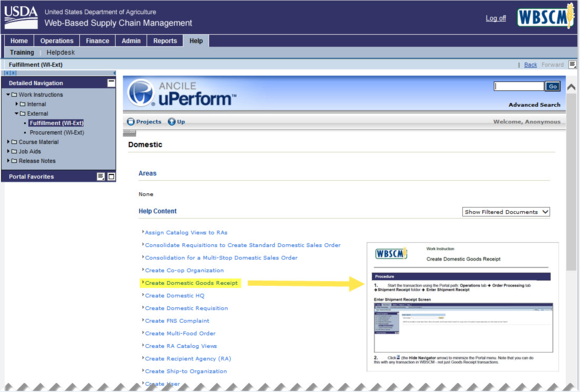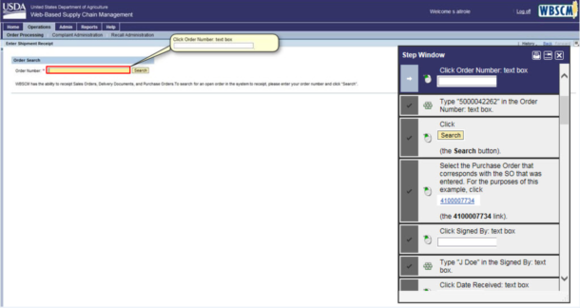
USDA Foods canned tuna is back! Due to a shift in the domestic availability
of this product, USDA Foods reintroduced canned tuna to The Emergency Food Assistance Program (TEFAP) beginning in March 2016. Canned tuna is an excellent source of protein and healthy fats and a great way
to meet the weekly servings of seafood recommended in the 2015 Dietary
Guidelines for Americans. Check out
the What's Cooking? USDA Mixing Bowl for recipe ideas like this tasty tuna
pasta casserole or apple
tuna sandwiches for some new, creative ways to use this pantry favorite.
|
 Detroit native Frank Kubik, Director of the Commodity Supplemental Food Program (CSFP) at Focus: HOPE, is a longtime champion of feeding the hungry in his community. His dedication and exemplary service were recognized with a 2015 Shining Light Award, an honor bestowed by the Detroit Free Press and Metropolitan Affairs Coalition on Metro Detroit leaders exhibiting integrity, spirit, and inspiration. Kubik's receipt of the Eleanor Josaitis Unsung Hero Award was especially poignant, as Josaitis was a co-founder of Focus: HOPE whose passion for helping people served as an inspiration to Kubik.
Kubik's career with Focus: HOPE began in 1981, when he was hired to work in the warehouse after losing his job as a parts inspector at Chrysler during the economic downturn. Kubik had run out of his savings, was on food stamps (now called the Supplemental Nutrition Assistance Program), and took the opportunity offered by a high school friend with the intention of staying perhaps six months. But he never left. Kubik transitioned to the Finance and Human Resources Department and then back to CSFP as Assistant Manager, Manager, and now Director. While he grew up in an economically challenged area of Detroit, he had no idea how hard life was for some people in his community until he went on a home delivery and saw what was in the house -- or not in the house: kids alone, with no food. That experience was an eye-opener and instilled in him a desire to do something about it.
Over the years, Kubik has seen CSFP transition from a program for mothers and children to the addition of seniors and now to a phase-out of women, infants, and children per the 2014 Farm Bill. His greatest challenge is reaching seniors who are homebound or isolated. Focus: HOPE CSFP operates in four counties with six pick-up sites and relies on community partners and volunteers to help pre-pack and distribute the food package boxes through additional venues to reach more than 41,000 clients each month. Kubik noted that the food from USDA has always been good quality, but he commended the improvements to the nutrition and quality of the food package and also observed that the ordering of food is now so much quicker, easier, and more efficient.
Kubik's ultimate hope for CSFP is that one day seniors will be well taken care of and have sufficient food so that the need for the program will diminish. In the meantime, his goal is for CSFP to reach all seniors in need, by expanding to the three states not currently operating CSFP and by increasing its reach in states with limited service areas.
Volunteers are integral to Focus: HOPE's work, and Kubik offered suggestions for outreach. Volunteers who tell others about their experience are the best recruiters. Kubik finds that people want to help but may not realize there is a need, so he speaks at schools, churches, and businesses, participates in community fairs and health fairs, and uses social media to share stories and recruit partners to his mission. Volunteers have offered free income tax preparation and free health screenings to CSFP clients, and the additional services benefit clients and also serve to inspire these volunteers to return and serve.
When a colleague informed him that he had been nominated and was selected to receive the Shining Light and Eleanor Josaitis Unsung Hero Award, Kubik was stunned and speechless. "We don't do this type of work for awards; serving people is a privilege," Kubik shared. He pointed to his team and to the great work being done all around the country and wondered what he did to deserve the accolades. The award was an honor and a humbling experience, and he is grateful and proud to be a recipient.
Thirty-five years after he stepped foot into the Focus: HOPE warehouse for what he thought was a temporary job, Kubik feels his work is as fresh and new as ever and feels fortunate to see first-hand how CSFP benefits people on the ground. "I'm grateful to be in this position and for the support and help of all the good people I've met along the way."
Read more about the 2015 Shining Light Awards and watch a video about Frank Kubik here.
|
USDA has published the Nutrient and Food Group Analysis of USDA Foods in Five of its USDA Food and Nutrition Programs. The report contains food and nutrient analyses of the USDA Foods distributed through five household and child nutrition feeding programs for Fiscal Year (FY) 2014 and School Year (SY) 2013-2014.
 Key findings of the report for foods offered and delivered through the Commodity Supplemental Food Program (CSFP) in FY 2014 include the
following nutrition contributions of the food package for individuals:
- 22 percent of elderly participants’ total energy needs and
- One-third or more of the recommended Dietary Reference Intakes (DRI) for several nutrients, including protein, calcium, iron, Vitamins A and C, and several B vitamins.
Key findings of the report for foods offered and delivered through The Emergency Food Assistance Program (TEFAP) in FY 2014 include:
- Food Banks are making healthy choices with their entitlement
dollars. Vegetables made up more than 30% of the total pounds ordered by
Food Banks using USDA Foods entitlement dollars in FY 2014. When
bonus foods are included, about 60% of the total pounds distributed by USDA are
fruits or vegetables.
- Meat and vegetables were equally important to the mix of USDA Foods delivered through TEFAP.
View the summary and full report
|
The following products have been added to the Foods Available List for TEFAP!
 New Videos on What’s Cooking? USDA Mixing Bowl
The What’s Cooking? USDA Mixing Bowl
website offers hundreds of recipes that can help you cook meals that are not
only healthy and affordable, but taste great, too! To make it even easier
to follow along, USDA recently added 16 step-by-step videos walking you through delicious What’s
Cooking? recipes like pumpkin soup, carne
adobada, and fruit crisp. The videos contain tips and techniques as
well as ideas for how you can customize the recipe for your family. Check out the What's Cooking? USDA Mixing Bowl Recipes playlist on YouTube!
|
Cooking Matters
Cooking Matters, part of Share Our Strength's No Kid Hungry campaign, offers free Educational Tools that chefs, educators, families, and community groups can use to inspire healthy food choices, with the mission of helping families shop for and prepare nutritious and budget-friendly meals. The site includes handouts with recipes and fun activities for kids - learn how to be a whole grain detective! - and toolkits and guides to facilitate nutrition education activities, such as food demonstrations. Check out Cooking Matters in Your Community and Cooking Matters in Your Food Pantry for checklists, recipes, activities, handouts, and culinary tips for your next food demo!
West Texans fighting food insecurity have a new resource to combat hunger. The West Texas Food Bank held the grand opening of their new 60,000 square foot location during a recent ceremony in Odessa. USDA Under Secretary of FNCS Kevin Concannon and Regional
Administrator Bill Ludwig were on hand to tour the new facility.
In operation since 1985, the West Texas Food Bank saw the need for food grow exponentially in their communities, requiring them to expand their services. The new facility replaces the East 2nd Street building, and is a first-of-its-kind in West Texas. Thanks to generous donations from area philanthropists committed to fighting hunger locally, the facility will help meet the nutritional needs of more than 31,000 people living in poverty or food insecurity in Midland County, while serving 18 other West Texas counties. According to the West Texas Food Bank Executive Director, Libby Campbell, the new facility offers more program opportunities for seniors, children, families and the homeless. Read more
The new West Texas Food Bank facility has a dedicated client service area to help fulfill patrons’ nutritional needs.
2016 National Anti-Hunger Policy Conference
This year's National Anti-Hunger Policy Conference, February 28-March 1 in Washington, D.C., had record-breaking attendance with more than 1,100 attendees! Feeding America and the Food Research & Action Center co-sponsored the event featuring three days of training, networking, and Capitol Hill advocacy. The goal of the event was for anti-hunger and anti-poverty advocates; federal, state, and local government officials; child advocates; representatives of food banks and food rescue organizations; sponsoring organizations; and nutrition and anti-obesity groups to learn about the latest news, research, and efforts on issues
related to hunger, nutrition, and poverty. Workshop sessions included a USDA Foods update for household programs.
Save the date for next year's conference: March 5-7, 2017, at the Omni Shoreham Hotel in Washington, D.C. See you there!
(Left to right) Kiley Larson, Polly Fairfield, Lindsay Walle, and Myesha Stephney-Dorsey of USDA attend the 2016 National Anti-Hunger Policy Conference
USDA
Issues Final Rule Extending New Religious Liberty Protections to Beneficiaries
of Federally-Funded Programs
On
April 4, 2016, USDA, along with eight other federal agencies, published the
final rule entitled Federal
Agency Final Regulations Implementing Executive Order 13559: Fundamental
Principles and Policymaking Criteria for Partnerships With Faith-Based and
Other Neighborhood Organizations. The final regulations – which are
being published after public
notice and comment – formally implement Executive
Order 13559 and will provide new religious liberty protections for
beneficiaries of federally funded social service programs, while also adding
new protections for the ability of religious providers to compete for
government funds on the same basis as any other private organization.
In
addition to these final regulations, each Agency will provide policy guidance
or reference materials to assist recipients of Federal financial assistance in
complying with these final regulations. These final regulations are
effective on May 4, 2016. Recipients must comply with these final
regulations by July 5, 2016. Further guidance from the Food Distribution
Division on implementing the provisions of this rule in our households programs
is forthcoming.
Publication
of Donated Foods Final Rule
The Food and Nutrition Service (FNS) published a final rule in the Federal Register, Requirements for the
Distribution and Control of Donated Foods & The Emergency Food Assistance
Program: Implementation of the Agricultural Act of 2014, on April 19,
2016. This rule revises and clarifies FNS regulations to ensure that USDA
Foods are distributed, stored, and managed in the safest, most efficient, and
cost-effective manner, at State and recipient agency levels. The rule
also reduces administrative and reporting requirements for State distributing
agencies, revises or clarifies regulatory provisions relating to accountability
for USDA Foods, and rewrites much of the USDA Foods regulations at 7 CFR part
250 in a more user-friendly, “plain language,” format. Lastly, the rule
revises and clarifies specific requirements in The Emergency Food Assistance
Program to conform more closely to related requirements in 7 CFR part 250 and
current law. View the final rule here.
 We have recently received many questions on raisin storage. Raisins are optimally stored under refrigeration, and tips for warehouse and home storage are below.
Reminder: General Storage Practices: State Distributing Agencies (SDA) and Recipient Agencies (RA) must ensure that USDA Foods are stored in a way that protects them from infestation, spoilage, damage, or other condition that may jeopardize the wholesomeness and safety of the foods. USDA Foods must be maintained in sanitary conditions, at the proper temperature and humidity, and with adequate air circulation. All SDAs and RAs must ensure that storage facilities have obtained all required Federal, State, and/or local health inspections and/or approvals and such inspections/approvals are current.
In the warehouse or pantry environment, refrigerated storage for raisins is highly recommended, especially during the summer months when the temperature in dry storage areas is more difficult to control. Temperatures above 70º F in dry storage areas may result in increased insect activity, such as weevils. Weevils, a type of beetle often found in grain-based food sources, tend to migrate toward sweet dried fruit once hatched. Please remember to keep raisins and other dried fruits away from grain-based foods such as cereals, rice, wheat flour, baking mixes, etc.
Tips to pass on to your clients: To maintain optimum freshness at home, raisins should be kept sealed in an airtight container in the coolest dry storage area or a refrigerator. This controlled, cool storage is the best way to keep raisins. As a result, raisins will retain their color, flavor, and nutritional value for up to five months if stored at 45° F or less. Raisins keep well for longer periods of time if frozen. They also thaw quickly at room temperature for a quick, convenient ready-to-eat healthy snack or can be added to salads, puddings, or baked items.
Are you interested in specific
information on storage and inventory management of USDA Foods? Review Food
Distribution National Policy Memorandum FD-107.
The Complaint Team is available
Monday-Friday, 6:00 a.m. – 5:00 p.m. Eastern Time. Email USDAFoodsComplaints@fns.usda.gov or call the
USDA Foods Complaint Hotline at 800-446-6991.
|
Helpful Resources for WBSCM Users
Several useful
resources are
available for new and experienced users alike that provide instructions, guidance, and general support information to help them work proficiently with Web-Based Supply Chain Management (WBSCM). These materials are regularly updated to correspond to the current best practices, application enhancements, and system requirements to provide convenient solutions to common questions.
USDA Website: Technical information and news about WBSCM on the public website includes Technical Information & Tools such as system requirements, browser settings, and technical tips; Upload/Download Guidelines & Templates for bulk updates and data integration with other systems; and a Newsletter Archive, which contains updates and reminders about WBSCM features, upcoming events, and Service Desk-recommended solutions to common problems.
WBSCM Forum: When logged in to WBSCM, users can see one or more discussion forums, depending upon their role in the system. These are used to announce new software releases, system outages, changes to browser or system requirements, upcoming deadlines, etc. Within WBSCM, navigate to Home -> News and Alerts.
Work Instructions: Step-by-step instructions and screenshots are available for common processes. These can be located by browsing by role and business function: Internal/External, Fulfillment/Procurement, and Domestic/International. A keyword search tool is also available after selecting a category. These materials can be accessed as simple or detailed instructions; many can also be viewed as interactive on-screen simulations. Within WBSCM, navigate to Help -> Training -> Work Instructions.
Job Aids: These are miscellaneous references to assist users with WBSCM. Examples include general instructions for running different types of reports, helpful hints, guidance for using wildcard characters in searches, and business rules. These resources are grouped by category: Finance, Fulfillment, Procurement, and Reports. Within WBSCM, navigate to Help -> Training -> Job Aids.
Release Notes: WBSCM is under continuous development to address known issues and/or introduce new or enhanced features. A description of the changes, the roles impacted, and links to related instructions are published with each release. Within WBSCM, navigate to Help -> Training -> Release Notes. The newest items can be found at the bottom of the list.
Hands-on Training: The WBSCM training environment (NTRN) is available for a variety of user roles. This safe environment provides trainers, trainees, and those who just want to practice using WBSCM with a copy of production data from 11/1/2013 from WBSCM for training on reports, placing orders, and more—all without impacting any real account activity. Contact the main WBSCM Service Desk at 877-WBSCM-4U (877-927-2648) or by email to WBSCMHelp@ams.usda.gov if you want access to NTRN.
 WBSCM Work Instruction Example
 WBSCM Simulation Example
-Bacteria -Chill -Clean -Cold -Cook -Danger Zone -Food -Freeze
-Gloves -HACCP -Hot -Safety -Storage -Thermometer -Wash
USDA staff will be participating in this upcoming national meeting in 2016. We look forward to the opportunity to meet you and hope to see you there!
May 9-11: American Commodity Distribution Association (ACDA) Annual Conference in St. Pete Beach, Florida
|
Here's how to sign up for these updates via GovDelivery:
1. Go to the Food Distribution website.
2. Click on the red envelope on the row of social media icons on the top right of the page.
3. Enter your email address and click "Submit."
4. Check the boxes to select your topics of interest. For these e-letters, scroll down to the Food Distribution category and click the plus sign to the left of the check box to expand the list and view all the sub-categories. Check these sub-categories to receive the corresponding e-letters:
*USDA Foods --> receive all "USDA Foods from Farm to Plate" general + program-specific e-letters
*Commodity Supplemental Food Program (CSFP) --> receive "Household Highlights" e-letter
*The Emergency Food Assistance Program (TEFAP) --> receive "Household Highlights" e-letter
*Food Distribution Program on Indian Reservations (FDPIR) --> receive "FDPIR Connection" e-letter
*Schools/Child Nutrition Commodity Programs --> receive "Spotlight on Schools" e-letter
5. Update your subscription preferences any time by following the above steps or clicking on the Subscriber Preferences Page link at the bottom of any of the e-letter email messages you receive from GovDelivery. Questions? Contact us at USDAFoods@fns.usda.gov.
|
|